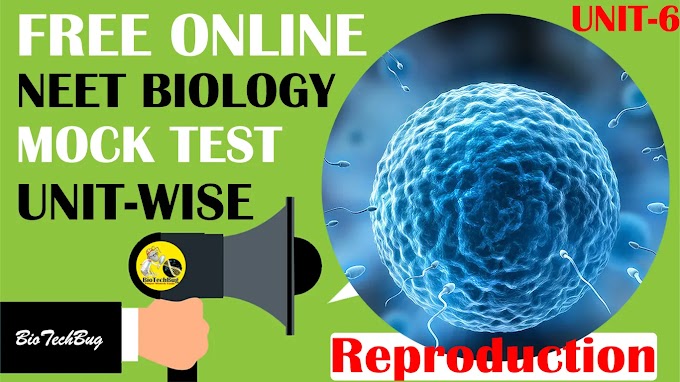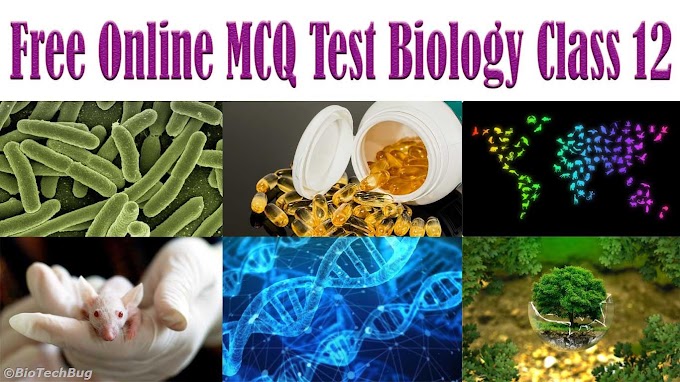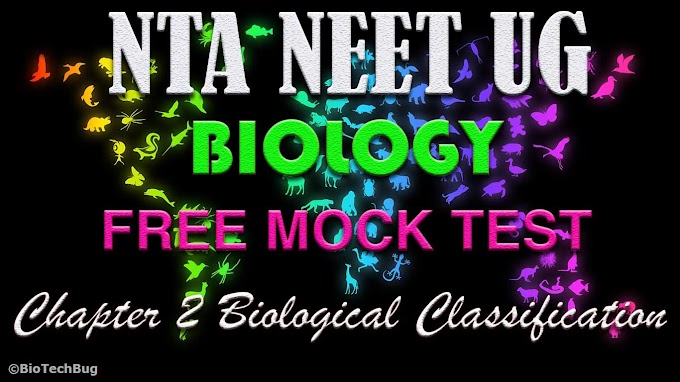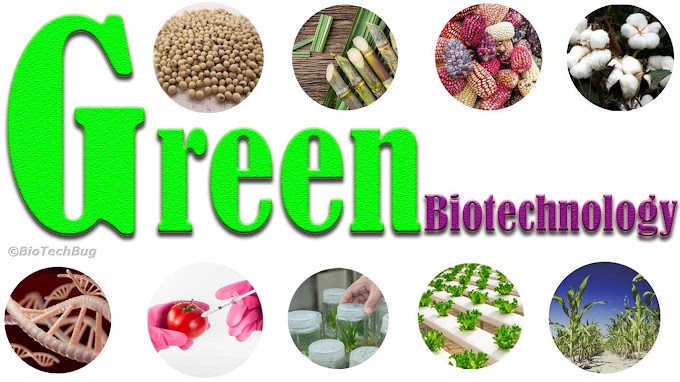Green Biotechnology is the
application of biotechnological techniques on plants to improve nutritional
quality, making them more drought-resistant and resistant to various diseases. All
Biotechnological techniques that are directly related to the plants, crops, and
agriculture fields come under Green Biotechnology.
Green Biotechnology includes the
development of genetically modified organisms, transgenic crops, hybrid
varieties, bio-fertilizers, bio-control agents, power generation, reduction of
environmental pollution, and uses of renewable energy resources. It reduces the
dependency of the agriculture field on chemical technologies by using
biotechnological techniques to increase productivity and reduce production costs.
Plant Biotechnology, Agriculture
Biotechnology, Plant tissue culture, etc. are the major Biotechnology subjects
that come under Green Biotechnology. So Green Biotechnology, Plant
Biotechnology, and Agriculture Biotechnology are used synonymously in their
broadest sense.
You Should Read: What are the colors of Biotechnology?
History of Green Biotechnology
Arising of Green Biotechnology is
directly related to the Green revolution. In the first green revolution from
1960 to 1975 new majorly grown crops such as wheat, rice, and maize varieties
were introduced that we're able to produce doubled or tripled yields. Later in
the second green revolution, the crops were tolerant to stress and resistant to
pests and diseases. The third green revolution was possible due to the
application of Biotechnological techniques in crops and various plants.
Genetically modified crops (GM
Crops) were developed in 1983 but permission to planting on fields was permitted in 1990 for the first time in China. Later Flavr Savr GM crop of
tomato got the license for human consumption by U.S. Food and Drug
Administration (FDA) in 1992. Then China first time commercializes the
transgenic crop of tobacco in 1993 with the introduction of the virus-resistant
gene. Later in 1996 Roundup Ready soybean GM crop was launched.
The golden history of Green
Biotechnology begins in 1996 when the first time genetically modified crops
were cultivated in the USA. Green Biotechnology has been adopted globally in
2006 and 10.3 million farmers of 22 countries cultivated the GM Crops on 102
million hectares of fields. Later 14 million farmers in 25 different countries
cultivated GM crops in 2009.
Importance of Green Biotechnology
Green Biotechnology plays a very
important role for farmers, consumers, and the environment. Some of the
benefits of its listed below.
- Biotech crops are increasing the yields by 6% - 30% on the same amount of land and facilities.
- They are resistant to many diseases and insects so it reduces the use of various harmful insecticides and pesticides.
- They produce good quality, safer, and healthier food and feedstuffs that are healthier and contain less harmful natural toxins.
- Farmers can grow these crops more efficiently and reliably in harsher climatic conditions.
- Increases the economic growth and quality of life for farmers and society.
- It helps in reductions in global greenhouse gases like CO2 emissions. It helps in the bioremediation of contaminated soils.
Tools and Techniques Used in Green Biotechnology
There are lots of Biotechnology
techniques used in Green Biotechnology including many old plant breeding
techniques like hybridization. Some of the major techniques used in it are listed
below.
1. Plant Tissue Culture
It is the main technique of plant
biotechnology to multiply genetically modified plants, pathogen-free
transplants, seedless varieties, and especially useful for those plants that do
not respond well to vegetative propagation.
Plant tissue culture uses
techniques like germplasm conservation, embryo culture, protoplast fusion,
genetic transformation, somatic embryogenesis, haploid production, and
organogenesis, suspension culture, callus culture, root culture, etc.
2. Micropropagation
It is a practice of rapidly
multiplying a selected plant using in vitro culture techniques. It helps
breeders to produce a large number of progeny plants in a limited time and
space.
3. Plant Genetic Engineering
Recombinant DNA technology,
mutagenesis, RNA interference, transgenic, polyploidy, somatic hybridization,
and genome editing is widely used. The most common genetically engineered
crops that are used commercially are cotton, maize, sweet potato, and soybeans.
4. Plant Molecular Marker
A molecular marker is a short DNA
sequence that is closely linked to the particular desirable gene which helps to
grow the crop with the desired trait. So these molecular markers are utilized
to select a particular trait in the plant.
5. Biofertilizers & Biopesticides
Biofertilizers, Biopesticides,
and Bio-control agents are the main tools of Green Biotechnology that reduce
the farmer's dependencies on harmful chemicals like pesticides, insecticides,
etc.
6. Plant Hybridization
Plant hybridization is a very old technique of crossbreeding among genetically dissimilar plants to produce a new hybrid plant that has both parent plants' qualities. Hybridization is mainly employed in the
breeding of domesticated plant varieties to transient hybrid vigor, move
desirable variation among lineages, and developed novel phenotypes. For example, hybridized tomato plants are more long-living than normal tomato
plants.
You Should Solve: Subject-Wise MCQs on Biotechnology
Green Biotechnology Applications
There are many applications of
Green Biotechnology, related to agriculture, environment, medical, and
industries. Some of the major applications of Green Biotechnology are listed
below.
1. Transgenic or Genetically Modified Crops Production
The main contribution of green
biotechnology to agriculture is to create a new species by the transfer of
interesting genes between different organisms to develop a plant of economic
interest. More than 32 different plants GM crops have been developed now like
soybean, cotton, maize, canola, alfalfa, apple, papaya, petunia, eggplant,
potato, cowpea, safflower, apple, sugarcane, etc.
GM crops are widely adopted by
farmers today. In this way, the products produced by these have higher
resistance and are easier to treat even in case of infection, so the loss of
crops is greatly reduced.
2. Bioenergy and Biofuel for Power Generation
The application of Green
Biotechnology for the production of biofuel products like bio-ethanol,
bio-methanol, biogas, and biodiesel. New GM crops have been developed to
increase the production of ethanol. For example, improved sugarcane variety has
been developed that has high productivity, drought tolerance, high content of
cellular fibers, high sucrose content, and walls that are easily broken.
3. Production of Biopolymers
The natural biopolymers sources
of plant origins are algae, seeds, and trees or their exudates. Plant breeding
for the production of biopolymers is the major application of green
biotechnology in biopolymers production like Polylactide, Xanthan gum,
Polyhydroxyalkanoate, and Starch polymers.
4. Phytoremediation (Bioremediation)
Phytoremediation is the clean-up
of metal- and metalloid contaminants from the soil or sediments. GM or
Transgenic plants now show very good results in this approach to promote
phytoextraction of metals like Cd, Pb, Cu, As, and Se from the soil. Overexpressing
genes encoding enzymes that are involved in the production of gas methyl-selenide
species promote the Phytovolatization of selenium compounds.
You Should Solve: MCQs
on Agricultural Engineering
Disadvances of Green Biotechnology
There are some disadvantages of
Green Biotechnology that also can cause harmful effects on us and our
environments.
1. Health Risks
In humans, health risks are
mainly allergic reactions. GM foods have specific proteins that can act as
toxins. They can change the metabolic pathway and stimulates an immune
response. For example, GM crop (StarLink maize) of maize that has a gene from the
bacterium Bacillus thuringiensis led to increased expression of the
protein CRY9C, which has allergenic properties.
Genetic modification in crops
leads to crop resistance to disease or makes it more tolerant to herbicides,
which could affect the ability of humans to defend against illness.
2. Environmental Risks
GM crops cause the losses of
terrestrial biodiversity and resistance to insecticides. Transgenetic plants
are grown in controlled environments they can be spread uncontrollably in the
environment and disturbed the biological equilibrium of the environment. Many
GM crops are dangerous to insects but insects like butterflies, and bees are not
actually dangerous to crops. There are chances to the mixing of GM plants with
conventional crops also.
3. Safety and Regulations
Transgenic crops and foods are
widely researched and reviewed by various government agencies. Every country
has different agencies for it. Each agency has different criteria for the
review process. In the US, the USFDA is the main authority to declare that
product is safe to eat. The production of GM crops and animals has social and
ethical issues also.
You Try to Solve: Quiz on Colors of Biotechnology
Future of Green Biotechnology
Global environmental challenges
and providing nourishment to all, force scientists to new technologies to
develop new plant varieties for tomorrow. Green Biotechnology is not limited to
only GM Crops only it has various fields of research where lots of research
work going on continuously and many of them already reached fields and also
available for use of humans use. The major research area under Green
Biotechnology is listed below.
- New GM Crops development
- Breeding Techniques
- Plants Gene Expression Analyses
- Biofortification
- Secondary Metabolites Production
- Plant and Microbe Interactions
- Multi-Omics Approaches
- Genotyping by Sequencing in Plants
- Genetic Resources Preservation
- Nanotechnology in Agriculture
- Phytoremediation
You Should Solve: MCQs
on Plant Biotechnology







